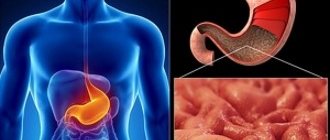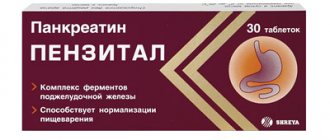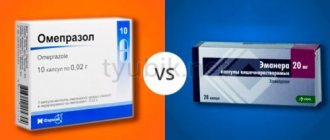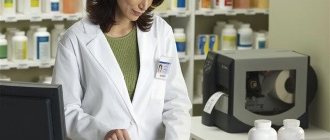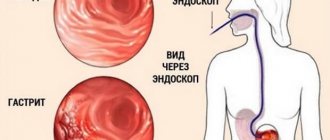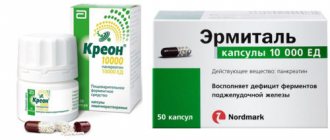Before using the drug Bifiform, you should read the instructions for use. The main feature of this medicine is that it contains microorganisms characteristic of the human intestine, such as enterococci and bifidobacteria. These microbes not only help digest food, but also help in the production of folic acid and vitamin E.
Pharmacology and pharmacodynamics
As already mentioned, the drug is intended to stabilize the intestinal flora. The constituent components help maintain normal intestinal microflora. Beneficial bacteria themselves are present in the body, but as a result of negative effects their balance can be disrupted. It is for this purpose that the medicine is prescribed. Active bacteria coming from the drug do not allow harmful bacteria to spread. The result is a positive effect on the digestive system.
Contraindications and precautions
Bifiform has virtually no contraindications
The medication should not be taken by people who are hypersensitive to any of the components of Bifiform. Capsules are also not recommended for patients suffering from individual intolerance to the following substances:
- glucose;
- dry lactose;
- soybean oil;
- yeast extract;
- titanium dioxide;
- acetyl monoglycerides;
- magnesium styrate;
- carob bean syrup.
What is the medicine Bifiform for?
As a rule, such drugs are used in the complex treatment of various diseases of the stomach, including intestinal infections. It can also be used as the only drug for treatment. Before use, it is better to consult with a specialist who can select the optimal dose taking into account the individual characteristics of the patient.
Indications include:
- loose stools, which is associated with the appearance of infection in the stomach and inflammatory processes in the gastric mucosa;
- use in combination with other drugs for the treatment of Helicobacter pylori infection;
- combination drug treatment of stomach diseases;
- the need to maintain the number of beneficial microbes in the child’s body for strong immunity and to prevent the occurrence of pathologies;
- complex drug treatment of bacterial and viral diseases of the digestive system.
Drug groups
Bifiform. Release form - capsules
Bifiform is available in various forms. By and large, this is due to the probiotics contained in the drug. Thus, the following forms of medicine exist on the pharmaceutical market:
- Capsules. They are based on enterococci and bifidobacteria, the usual habitat of which is the intestines. In addition, the capsules contain nutrients that accelerate the proliferation of beneficial bacteria in the internal environment of the intestines. The main characteristic is acid resistance. Age limits are from two years and above.
- Powder "Baby". It is a biological food additive. Sold in powder form with different flavorings. Consists of lactobacilli and bifidobacteria. In addition, the composition contains a concentration of B vitamins. Indications for use: dysbacteriosis in children from one to two years old.
- Chewable tablets "Baby". Developed on the basis of lactobacilli, bifidobacteria and B vitamins. Serve as a prophylactic against dysbacteriosis for children aged three years and older.
- Baby drops. Mostly they consist of streptococci and bifidobacteria. In small concentrations there are also substances that promote their engraftment in the intestinal microflora. Prescribed for newborns as a prophylaxis against dysbacteriosis.
How to take Bifiform
The capsule should be swallowed whole and washed down with a glass of water. If the capsules are taken by small children or for other reasons it is not possible to take the entire capsule, then you need to carefully split the capsule and dissolve its contents in 1 tbsp. l. water.
The dosage, duration of treatment and frequency of administration depend on the disease and the characteristics of its course.
For acute diarrhea, it is prescribed to take 1 capsule 4 times a day. You can take it until the problem completely disappears.
On a note! With prolonged loose stools, the body loses a lot of fluid, which must be compensated for (drink as much water as possible).
Children over 2 years old are given 1 capsule 3 times a day. A more precise dosage and frequency of administration can be determined by your pediatrician.
In order to strengthen the immune system, up to 3 capsules per day are prescribed. The duration of the treatment course can take from 1 to 3 weeks.
If after several days of taking the medicine, loose stools do not disappear, then you need to inform a specialist.
The drug in children's form Bibiform Baby can be given to children from birth to 2 years. It is enough to take 0.5 g per day with food. Treatment can last from 10 to 20 days.
On a note! Taking the drug does not affect psychomotor reactions in any way.
Area of influence of the drug
Bacteria, being part of the medicine, perform three very important functions:
- Produce lactic and acetic acid.
- Create a protective barrier around the small and large intestines.
- Activate the activity of the digestive tract.
It is these functions that block the spread of pathogenic phenomena, contribute to the normalization of intestinal microflora and are the foundation for healthy intestinal function. Bifiform’s area of expertise also includes the prevention and treatment of gastrointestinal diseases. This is especially true for severe forms of illness.
After a course of taking the drug, you can say goodbye to such unpleasant disorders as diarrhea, constipation and flatulence. Another positive point is strengthening the immune system. This happens in a similar way: the cleansed intestinal lining and the entire digestive organ as a whole improve the functioning of lymphoid tissue, which, as is known, determines human immunity.
Another indisputable fact is that the intestinal microflora is responsible for the absorption and production of vitamins, as well as the release of enzymes necessary for food processing. This is why the drug is so often prescribed to children.
Bifiform during pregnancy
Many people have the misconception that most medications cannot be used during pregnancy. But there are medications that are not contraindicated. These include Bifiform. The drug alleviates the condition of pregnant women by normalizing metabolic processes in the body and intestinal microflora.
The instructions say that pregnancy is not a contraindication. Bifiform is a probiotic that normalizes intestinal health. But before taking it, it is better to consult a doctor. Taking the drug does not affect the developing fetus in any way.
Bifiform: pharmacological properties
Bifiform - natural probiotic
The drug is a probiotic and is available in three forms. Capsules are used in the treatment of adults, and chewable tablets and powder are prescribed for children. Bifiform capsules are endowed with the most beneficial properties. Firstly, the medicine enters the intestines in its entirety.
There it dissolves, which allows all the beneficial components to act directly on the affected area. Secondly, one capsule contains a sufficient number of microorganisms so that the disturbed intestinal microflora begins to recover.
As for chewable tablets and powder, they do not belong to the group of drugs, but are considered just food additives. This fact does not in any way affect their medicinal qualities. The biological supplement Bifiform contains the same B vitamins and bifidobacteria as the capsules. In addition, so that taking them does not cause any difficulties for the youngest patients, the tablets are available in different fruit and berry flavors.
Another positive pharmacological property is high resistance to various antibiotics.
In what cases of intestinal stagnation is Bifiform prescribed?
The main effect of the drug is aimed at restoring the microflora of the stomach and intestines. Therefore, this drug is prescribed for constipation caused by the following diseases:
- intestinal infections;
- gastritis, gastric ulcer and enterocolitis;
- inflammation of the pancreas (pancreatitis);
- liver problems;
- dysbacteriosis;
- colitis;
- decreased natural enzyme production;
- deterioration of digestion and absorption of food.
In addition, Bifiform is often prescribed as an additional drug in the treatment of constipation caused by food poisoning.
Bifiform for constipation has mostly positive reviews. The drug is absolutely harmless, so it can be given to children and elderly patients without fear. It is often recommended to be taken for problems with bowel movements that occur after long-term treatment with antibiotics and antihistamines.
Bifiform is also prescribed for the prevention of constipation during the postoperative and postpartum period. If constipation occurs as a result of complex preparation for surgical intervention, when the natural flora is disturbed during intestinal lavage, then Bifiform will also come in handy.
Another drug that can help with constipation is Acepol - the drug normalizes intestinal function quickly and gently. Check out our review and recommendations for this drug.
Probiotics for IBD
Inflammatory bowel diseases include ulcerative colitis (UC) and Crohn's disease (CD), idiopathic recurrent diseases in which chronic immune inflammation of various parts of the gastrointestinal tract is observed with the development of diarrhea and abdominal pain. UC and CD have both overlapping and independent clinical and pathological features.
Risk factors for the development of IBD include a family history of inflammatory bowel disease, social and geographic factors, stress, medications (nonsteroidal anti-inflammatory drugs), increased intestinal permeability, use of oral contraceptives, obesity, and a diet high in carbohydrates [9].
The pathogenesis of IBD is not fully understood, but genetic and environmental factors such as altered gut bacteria and increased intestinal permeability play a role in the dysregulation of intestinal immunity, leading to inflammatory bowel disease. It was not possible to detect a specific environmental factor, nutrition, or infectious agent that causes IBD. At the same time, scientific facts indicate a key role of the intestinal microbiota in the occurrence and progression of IBD [11, 12].
UC and CD have much in common in the morphological picture of inflammation, the mechanisms of its development and clinical manifestations. Unlike UC, which occurs with isolated damage to the colon, with CD, any part of the digestive tract can be involved in the pathological process. The clinical picture of CD is more mosaic; there are differences in types of complications, prognosis and response to therapy.
For the treatment of IBD, drugs 5-aminosalicylic acid (5-ASA), corticosteroids, azathioprine, methotrexate, 6-mercaptopurine, cyclosporine, antibodies to tumor necrosis factor and other biological therapies are used [13].
Since the microflora plays a role in the pathogenesis of IBD, a number of interventions may be aimed at modulating the intestinal microbiota. This effect is achieved in several ways: antibiotic therapy, the administration of pro- and prebiotics, changing the nature of the diet, etc. It is believed that probiotics containing viable organisms can have a positive effect on the intestinal microbiota and the course of the disease [14, 15].
In recent decades, data from many randomized clinical trials (RCTs) on the effectiveness of probiotics in IBD have been published all over the world, however, when considering all these works separately, it is impossible to get a holistic picture of their role in the treatment of this pathology. This is due both to the inconsistency of the results of these RCTs and to the significant heterogeneity of the comparison groups, different types and dosages of probiotics, different follow-up periods, etc. In addition, in many RCTs the compared groups were small in number, which is why when comparing them there was statistical significance cannot be achieved. In this regard, meta-analyses emerged that synthesized data from several individual RCTs.
In total, by 2016, 36 meta-analyses had been published that synthesized data from RCTs that examined the effectiveness of probiotics in specific subgroups of patients with IBD, but none of them pooled the entire population of RCTs on this problem.
When assessing the methodological quality of these meta-analyses using the Canadian Agency for Drugs and Technologies in Health rating system, 4, 24, and 8 of them were classified as being of high, moderate, and low quality, respectively, and some of them were serious limitations [16]. For example, several meta-analyses combined RCTs of probiotics and synbiotics, while others simultaneously assessed RCTs conducted in pediatric and adult populations [17–22].
The most modern, complete and structured view of the currently accumulated evidence base for the use of probiotics in IBD in adults is presented in a systematic review with a meta-analysis of RCTs, the results of which were published in 2017 [23].
A total of 22 RCTs were included in the review, which studied the effectiveness of probiotics in inducing remission in active UC (8 RCTs), anti-relapse effectiveness in UC (6 RCTs), effectiveness in inducing remission in active CD (2 RCTs), anti-relapse effectiveness in CD ( 2 RCTs) and after bowel resection for CD (4 RCTs).
Efficacy of probiotics in inducing remission in active ulcerative colitis
A total of 8 RCTs were included in the review, which examined the effectiveness of probiotics in inducing remission in active UC. One of them compared probiotics with 5-ASA, and the other 7 were placebo-controlled. An RCT comparing probiotics ( Escherichia
Coli Nissle 1917)
and 5-ASA (mesalazine) to induce remission in active UC included 116 patients. Treatment in both groups was carried out for 12 weeks; When included in the RCT, patients in both groups received gentamicin for 1 week [24].
18 (31.6%) of 57 patients receiving probiotics and 15 (25.4%) of 59 patients receiving 5-ASA did not achieve remission (relative risk of not achieving remission 1.24; 95% CI 0. 70—2.22). Adverse treatment side effects occurred in 9 (15.8%) patients in the probiotic group and 7 (11.9%) in the 5-ASA group ( p
=0,54).
Seven placebo-controlled RCTs [25–31] included a total of 535 patients with active UC. A total of 166 (56.3%) of 295 patients receiving probiotics did not achieve remission compared with 159 (66.3%) of 240 receiving placebo (RR 0.86; 95% CI 0.68 to 1.08 ). Data on adverse treatment effects were reported in 6 RCTs [25–28, 30, 31]. Adverse events occurred in 69 (24.6%) of 281 patients receiving probiotics and 28 (12.4%) of 226 randomized to placebo, although this difference was not statistically significant (RR 1.21; 95% CI 0.64-2.27).
In 3 studies with a total number of 319 patients, VSL#3 (Ferring Pharmaceuticals Ltd., UK) was used, a combination probiotic consisting of strains of Bifidobacterium
breve , B. longum , B. _ infantis , Lactobacillus acidophilus , L. _ plantarum , L. _ paracasei , L. _ bulgaricus
and
Streptococcus thermophilus
[26, 29, 30]
.
A separate meta-analysis of these 3 RCTs showed that 91 (56.2%) of 162 patients treated with VSL#3 and 118 (75.2%) of 157 placebo groups failed to achieve remission (RR 0.74, 95 % CI 0.63–0.87). The number of patients needed to treat with VSL#3 to prevent one failure to achieve remission in active UC (NNT) was 5 (95% CI 4-10). Two RCTs involving 140 patients used the probiotic Escherichia
Coli Nissle 1917
. Fifty-six (58.9%) of 95 patients receiving the probiotic failed to achieve remission compared with 18 (40.0%) of 45 in the placebo groups (RR failure to achieve remission 1.56; 95% CI 0.44, 5.53 ).
Anti-relapse effectiveness of probiotics in ulcerative colitis
Three of the six RCTs that examined the antirelapse efficacy of probiotics in patients with clinical remission of UC compared probiotics with 5-ASA [32–34], and three RCTs [35–37] were placebo-controlled. The 3 RCTs that used 5-ASA as a comparison included a total of 555 patients with clinical remission of UC.
Relapse occurred in 110 (39.7%) of 277 patients receiving probiotics and 109 (39.2%) of 278 receiving 5-ASA. The RR of relapse in patients with clinical remission of UC treated with probiotics versus 5-ASA was 1.02 (95% CI 0.85–1.23). Adverse side effects were reported in 73 (25.6%) patients receiving probiotics and 66 (23.2%) patients receiving 5-ASA (RR 1.09; 95% CI 0.71–1.67) .
Three placebo-controlled RCTs [35–37] included 122 patients with clinical remission of UC, of whom relapse occurred in 32 (49.2%) of 65 patients receiving probiotics and 42 (73.7%) of 57 groups. placebo (RR 0.62; 95% CI 0.33–1.16). Only one of these RCTs reported adverse events, all of which occurred in placebo users [37].
Efficacy of probiotics in inducing remission in active Crohn's disease
The effectiveness of probiotics in inducing remission in active CD was studied in only 2 placebo-controlled RCTs, including a total of 37 patients [38, 39]. Of these, 6 (31.6%) of 19 patients receiving probiotics failed to achieve remission compared with 6 (33.3%) of 18 in the placebo groups (RR 0.99; 95% CI 0.57-1. 72). Only one of these RCTs reported adverse events that occurred in the placebo group only [38].
Anti-relapse effectiveness of probiotics in Crohn's disease
The review included only 2 RCTs ( n
=195), which compared the anti-relapse effectiveness of probiotics [40, 41].
Relapse occurred in 52 (52%) of 100 patients receiving probiotics and 50 (52.6%) of 95 placebo patients (RR of relapse, 1.03; 95% CI, 0.70 to 1.51). Only one of these RCTs [40] reported adverse events, which occurred in 49 (58.3%) of 84 patients in the probiotic group and 45 (55.6%) of 81 in the placebo group ( p =
0.72). .
Anti-relapse effectiveness of probiotics after bowel resection for Crohn's disease
A total of 4 placebo-controlled RCTs were included in the review ( n
=333), which examined the effectiveness of probiotics in preventing either clinical or endoscopic recurrence of CD during remission after bowel resection [43–46]. In 3 of these 4 RCTs, the outcome studied was clinical relapse, which occurred in 28 (26.7%) of 105 patients receiving probiotics and 28 (25.9%) of 108 receiving placebo (RR 1.06, 95 % CI 0.59, 1.92) [43–45].
Information on endoscopic recurrence of disease activity was provided in all 4 RCTs. To determine endoscopic recurrence, the Rutgeerts scale was used [42] with a score from 1 to 4.
The results of these RCTs showed that probiotics do not prevent endoscopic recurrence of CD. Three RCTs reported adverse events occurring in 39 (30.2%) of 129 probiotic-treated patients and 52 (38.8%) of 134 placebo-treated patients (RR 0.81, 95% CI 0.61–1.08) [43, 45, 46].
In summary, this systematic review and meta-analysis demonstrated that the probiotic VSL#3 helps induce remission in active UC with NNT=5. It has also been found that probiotics may be as effective as 5-ASA in preventing relapse of UC that is in remission. There was no benefit of probiotics over placebo in inducing remission in active CD, preventing relapse of CD in remission, or preventing clinical or endoscopic recurrence of CD after surgical treatment. Comparison of the incidence of adverse events during treatment with probiotics, placebo and 5-ASA did not reveal statistically significant differences.
Diet for constipation in children
Since the main allergen in young children is CMP, the main principle of diet therapy is the complete exclusion of cow's milk and products based on it from the diet of a sick child or the mother's diet if the child is breastfed. If a breastfed child has severe manifestations of allergies or polyvalent sensitization occurs, then in addition to dairy products, other potentially allergenic foods should be excluded from the mother’s diet - eggs, gluten, fish, seafood .
Mixtures with partial protein hydrolysis contain peptides of a sufficiently large size that can cause an allergic reaction in sick children, so they cannot be recommended as a therapeutic mixture for patients with an allergy to CMP. Their use for preventive purposes is currently being actively studied, but there is still no clear opinion about their effectiveness. It is preferable to use formulas based on deep protein hydrolysis .
For the treatment of constipation caused by lactase deficiency, formula-fed children may be recommended adapted milk formulas with various reduced lactose contents.
In severe cases of lactase deficiency or for religious reasons in children over 6 months of age, it is possible to use a mixture based on soy protein: Nutrilon-soy, Friso-soy, Enfamil-soy, Humana-SL
The use of probiotics for liver diseases
Hepatic encephalopathy
Hepatic encephalopathy is a common complication of chronic liver diseases, which is brain dysfunction due to liver failure and/or portosystemic shunting and manifests itself in a wide range of neurological and mental disorders (from subclinical manifestations to coma). The main drugs for the treatment of hepatic encephalopathy are non-absorbable disaccharides (lactulose) and antibiotics (rifaximin).
Interest in the use of probiotics for hepatic encephalopathy is associated with the scientific data accumulated to date on the significant role of intestinal microbiota in the pathogenesis of liver diseases. It is known that long-term intestinal dysbiosis, especially bacterial overgrowth syndrome, leads to the development of non-alcoholic steatosis and steatohepatitis, intrahepatic intralobular cholestasis, as well as functional disorders of the extrahepatic biliary tract [47].
The possibilities of influencing the intestinal microflora are being actively studied today, but are still quite limited. Most studies are devoted to dietary correction, the effects of pre- and probiotics. The most complete evidence base regarding the use of probiotics in hepatic encephalopathy is presented in the recently published Cochrane review (2017) [48].
The review authors summarized RCTs published up to and including June 2016 that examined any probiotic at any dose compared with placebo, no intervention, or any other treatment in patients with any degree of acute or chronic hepatic encephalopathy.
A total of 21 RCTs were included in the review ( n
=1420). Of these, 14 compared probiotics with placebo or no treatment, and 7 with lactulose. The duration of treatment ranged from 10 to 180 days. The most commonly used probiotic was VSL#3.
Compared with placebo or no intervention, probiotics had no effect on mortality (7 RCTs; n
=404; RR 0.58; 95% CI 0.23–1.44).
Incomplete resolution of hepatic encephalopathy symptoms was less common among patients treated with probiotics (10 RCTs; n
=574;
RR 0.67; 95% CI 0.56–0.79). Compared with no treatment, patients with minimal hepatic encephalopathy who received a probiotic were less likely to develop clinically overt encephalopathy (10 RCTs; n
=585; RR 0.29; 95% CI 0.16–0.51), but there was an effect on the incidence hospitalizations and treatment refusals/changes were uncertain. Compared with no treatment, probiotics improved quality of life, but this finding is based on three trials with low quality evidence.
Patients treated with probiotics had lower plasma ammonia levels than those without treatment (10 RCTs; n
=705; mean difference 8.29 mmol/L; 95% CI 13.17–3.31).
All RCTs comparing probiotics with lactulose were of very low quality, and the comparison results were not statistically significant for all endpoints studied: all-cause mortality (2 RCTs; n
=200;
OR 5.0; 95% CI 0.25—102.00); incomplete resolution of symptoms (7 RCTs; n
= 430; RR 1.01; 95% CI 0.85–1.21);
complications associated with the development of clinically obvious hepatic encephalopathy (6 RCTs; n
= 420; RR 1.17; 95% CI 0.63-2.77);
number of hospitalizations (1 RCT; n
= 80; RR 0.33; 95% CI 0.04–3.07);
drug intolerance leading to treatment discontinuation (3 RCTs; n
= 220; RR 0.35; 95% CI 0.08–1.43);
treatment change/discontinuation (7 RCTs; n
=490; RR 1.27; 95% CI 0.88–1.82);
quality of life (1 RCT; n
=69);
plasma ammonia concentration (6 RCTs; n
= 325; mean difference –2.93 mmol/L; 95% CI 9.36–3.50).
Based on the results of the review, the authors concluded that, compared with placebo or no intervention, the use of probiotics in patients with hepatic encephalopathy improves recovery, prevents the development of clinically overt hepatic encephalopathy, improves quality of life and leads to a decrease in plasma ammonia concentrations, but little or nothing. does not affect mortality. The benefit of probiotics over lactulose in hepatic encephalopathy cannot be assessed due to the very low quality of the available evidence. To clarify the true effectiveness of probiotics in hepatic encephalopathy, high-quality RCTs that meet the standards of their implementation and reporting of results are needed.
Non-alcoholic fatty liver disease
Non-alcoholic fatty liver disease (NAFLD) is a disease or spectrum of diseases resulting from excess accumulation of fats (mainly triglycerides) in the liver with the development of steatosis affecting more than 5% of hepatocytes, in the absence of alcohol consumption in toxic doses, the use of steatogenic drugs or congenital violations [49]. NAFLD is a multisystem disease that increases the risk of type 2 diabetes mellitus (T2DM), cardiovascular disease, chronic kidney disease, osteoporosis and hypogonadism [50]. Currently, the incidence of NAFLD is increasing worldwide, making it the most common form of liver damage among the population of industrialized countries. NAFLD can occur in various forms from hepatic steatosis to steatohepatitis and cirrhosis, and is also one of the causes of the development of hepatocellular cancer [51].
As with hepatic encephalopathy, interest in the use of probiotics in NAFLD is associated with scientific evidence of the significant role of the intestinal microbiota in the pathogenesis of liver diseases. Recent publications also indicate a potential role of microbiota in the development of NAFLD. Because the liver and intestine are anatomically connected through the hepatic portal system, the intestinal microflora and its metabolic byproducts can influence liver pathology [52]. In this regard, probiotics have been proposed as a treatment option for NAFLD due to their modulating effects on the microbiota. The intestinal microbiota exerts its effect through the formation of insulin resistance, influence on the metabolism of lipids, proteins and carbohydrates and the induction of obesity, as well as hepatotoxic bacterial products such as ethanol [53].
In 2007, the results of a Cochrane systematic review on the effects of probiotics and synbiotics on obesity, insulin resistance, T2DM and NAFLD were published [54]. The authors systematically searched for RCTs examining the use of probiotics in NAFLD among publications available in five databases up to May 2006, without restrictions on age or language. Selection criteria included RCTs evaluating treatment of NAFLD with probiotics at any dose, duration, regardless of route of administration, compared with no intervention, placebo or other methods.
As a result, no RCTs that met the inclusion criteria were found. Preliminary data from two non-randomized pilot studies suggested that probiotics may be well tolerated, improve liver function tests, and reduce levels of lipid peroxidation markers. The authors concluded that due to the lack of RCTs, it is not possible to either support or refute the benefit of probiotics in patients with NAFLD.
Since the publication of this systematic review, at least 5 RCTs have been conducted to date. In a placebo-controlled RCT, R. Aller et al. [55] studied the effect of probiotics L. bulgaris
and
S. thermophilus
on various parameters of liver function and risk factors for cardiovascular diseases. The results of the RCT showed that the study probiotics, compared with placebo, led to a decrease in the levels of alanine aminotransferase (ALT), aspartate aminotransferase (AST) and gamma-glutamyl transpeptidase (γ-GTP), and therefore the authors concluded that probiotics have a positive effect on liver function.
L. acidophilus over 8 weeks.
La5 and
B. lactis
Bb12 (
n
=36), with regular yogurt (
n
=36) in patients with NAFLD. Bb12 consumption resulted in decreased serum levels of ALT, AST, triglycerides, and low-density lipoprotein cholesterol [56].
Later A. Alisi et al. [57] published the results of an RCT that compared the effects of VSL#3 ( n
=22) and placebo (
n
=22) on the severity of fatty liver disease (according to ultrasound) in children with NAFLD. Treatment was carried out for 4 months. Children taking VSL#3 showed a significant reduction in the severity of fatty liver disease and body mass index. These data, according to the authors of the RCT, indicate that the use of VSL#3 may improve the severity of fatty liver disease and, therefore, prevent the progression of NAFLD.
In an RCT, P. Vajro et al. [58] showed that in obese children with NAFLD, taking the probiotic L. rhctmnosus
GG is associated with a significant reduction in serum peptidoglycan polysaccharide antibody titers, which are an indirect indicator of the severity of small intestinal bacterial overgrowth syndrome. In addition, in the group receiving the probiotic, there was an improvement in liver function in the form of a decrease in ALT.
Also, a placebo-controlled RCT by A. Sepideh [59] showed a positive effect of probiotics on glycemic (glucose, insulin, insulin resistance) and inflammatory (TNF-α and IL-6) parameters in patients with NAFLD.
The results of these 5 RCTs add little to the conclusions of the authors of the 2007 Cochrane review, since all of these studies examined indirect (surrogate) endpoints (measures of liver function, etc.), rather than clinically significant outcomes such as mortality, development of coronary heart disease, T2DM, chronic renal failure, etc.
Thus, given the current evidence base, it is impossible to draw a conclusion either for or against the use of probiotics in NAFLD.
